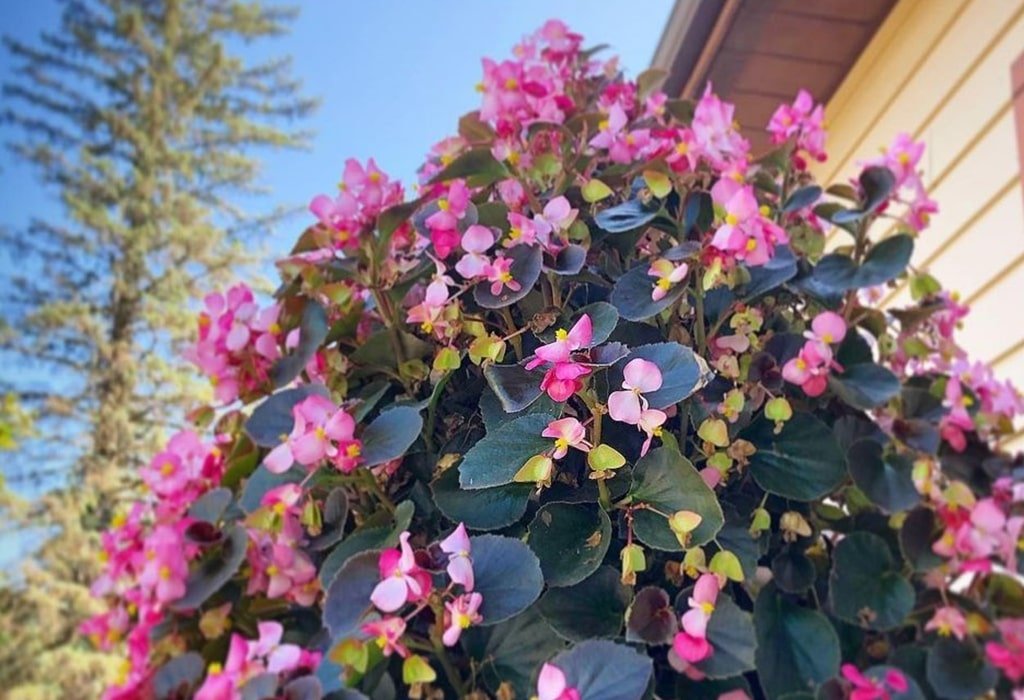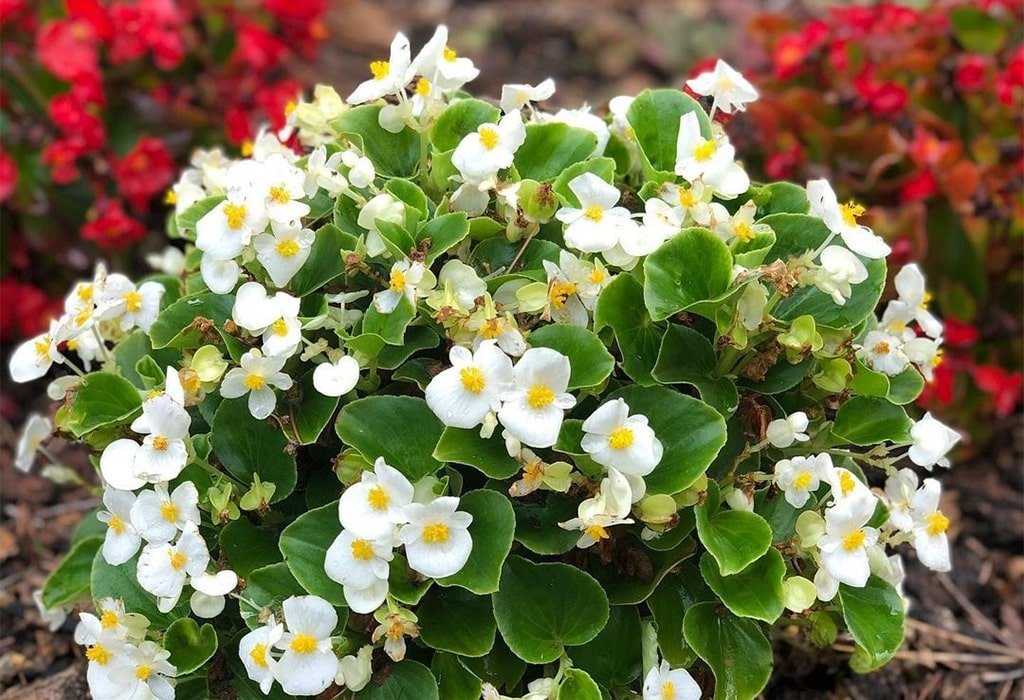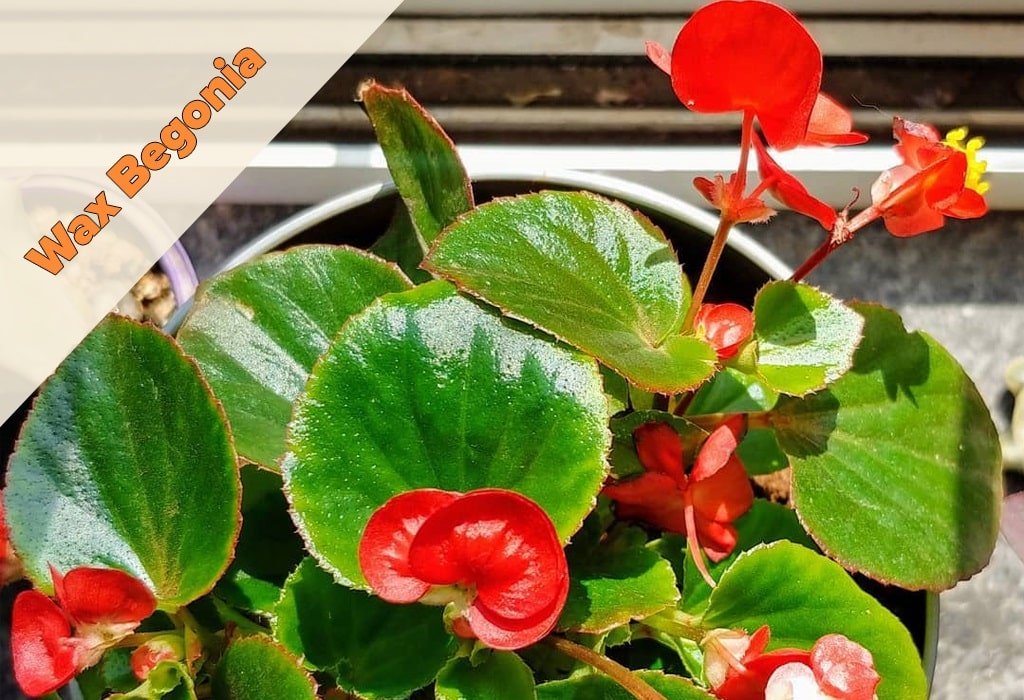Are you searching a plant for creating your garden attractive than wax begonia is a nice choice? Wax begonias are among the foremost, well-liked of cultivated plants for indoors or outdoors. These beautiful plants are big for each their leaf forms and their blooms.
The flower genus of plants includes 1,500 named species and several other thousand hybrids. The flower is one of every of the most important genera of flowering plants. The plants are synoecious, with sexual male and feminine flowers occurring severally on a similar plant.
The male contains varied stamens, and therefore the female includes a massive inferior ovary and 2 to 4 branched or twisted stigmas. Some Wax begonias are big principally for their stunning, usually exotically coloured foliage, others for their engaging, well endowed and long flowers.
What is the Wax Begonia?
This is the genus of the family “Begoniaceae“. This is often a genus of perennial flowering plants.
Wax Begonia is robustly very few compact garden plants, growing around a foot high.
Wax begonia may be a hardy perennial that brings bright blooms to your home and garden for the bulk of the year.

Different Names of Wax Begonia
Other names of this plant are
- Begonia cucullata
- Clubed begonia
Wax begonia scientific name is Begonia x semperflorens cultorum.
Wax Begonia History
The origin of the flower was ordinarily thought to be in Brazil, although some were found in the North American country at an earlier date. Therefore the Chinese used them within the 14th century.
However, the primary person to document the invention of the flower was a Franciscan monk, Charles Plumier, who found fibrous Wax begonias in Brazil in 1690.
Wax begonia Flowers and leaves
Flower:
They bloom with 1-1/2-inch single or double flowers in reminder red, pink, or white.
Leaves:
The leaves square measure shiny, rounded, green or achromatic leaves.
Wax Begonia Seed Planting
Below are the steps of planting wax begonia.
- When to plant?
Plant them outdoors in late spring once the soil is heat. and every one danger of frost has passed.
- Where to plant?
Wax begonias do best partly shade, significantly throughout the summer months. Use these compact plants in borders and/or mass plant during a flower bed. For best results, plant Wax begonias in wealthy, moist, well-drained soil.
- How much water does this plant need?
Keep the soil slightly wet. Water once or doubly per week. The most rule of thumb for watering Wax begonias is not to let the soil dry out utterly overwatering, which can cause the foliage to show yellow and eventually drop.
- How much sunlight does this plant need?
Wax begonias will tolerate many sun wax begonia plants that grow and bloom best beneath the full sun. Most Wax begonias grow best partially shade four to six hours of the direct morning sun daily or filtered sun.
- How kind of soil does the wax begonia plant need?
Wax begonia would like a well-draining soil or potting combine to simplify this task. Use light-weight potting soil with additional perlite to push correct emptying.
- How huge of a pot do Wax begonias need?
For one flower plan,t take a 6 in. pot is that the smallest suggested size.
- How huge could be a begonia?
They grow twelve to eighteen inches tall and wide and thrive partly shade to full shade locations.

How does Wax Begonia Plant Grow?
- Wax Begonia plant is easy to grow in pot and container.
- The best time to require cuttings is within the spring once the plants begin to grow.
- These plants won’t turn out accurately from seed; however, like several different Wax begonias, they propagate simply from leaf-tip cuttings.
- Take cuttings while not blooms, however a minimum of 2 nodes and bury them within the wet potting soil combine.
- Then leave during a heat, semi-shaded spot till new growth seems.
- After few weeks, it will begin to grow.
Wax Begonia Care
Right location:
Wax begonia likes wealthy soil. They like wet, well-drained location is perfect, and mulch can keep the roots shaded. East, west, or south-facing windows are best. If any burning happens once fully grown during a south-facing window, move the plant farther from the window.
As another, they grow well beneath grow lights. Place wherever dry air from heater vents won’t blow directly on them. In pots, take care to supply, drain holes. A peat-based potting combine is good for containers.
Watering:
Put your plants on an everyday watering schedule. Once or double every week, looking on the prevailing atmospheric condition to stay the soil slightly damp, not wet or soggy. Water round the base of the Wax begonia plant.
Water potted and hanging basket wax Wax begonias additional result from them typically dry out additional quickly than those growing within the garden. Continuously water your wax begonia by hand, employing a hose or container and if you want to water from overhead.
Stop watering when you see the water start all-time low in the pot and discard the excess water that accumulates within the drain receptacle.
Sun-light:
Begonia likes partial shade and indirect daylight. Wax begonia plants grow and bloom best underneath the full sun. However, occasionally you may be needed to supply some shade from the recent afternoon sun Morning sun is ideal for Wax Wax begonias.
Stem Wax begonias like additional shade and less heat; thus, we frequently see them on show in late summer. Wax begonias use the sturdy summer daylight for their main blooming amount. As a result of blossoms should endure heat conditions, your soil should stay moist for the best flowering.
Pruning:
Cutting giant, overgrown Wax begonias are also necessary to revive them to their usual form. Use clean, sharp shears or a knife to cut the stems back to a leaf node.
Wax begonias are prone to, at intervals, three inches of the soil revitalize them, if necessary; however, pinching and pruning isn’t the tip of the story. Sterilize pruning tools with house disinfectant spray before and when use.
It would help if you cut them duplicate to 1/3 of the plant when flowering. If you’ve got winter-flowering Wax begonias, cut them back within the spring when they need finished flowering.
Fertilizing:
Apply an all-purpose slow-release fertilizer at the time of potting and liquid fertilizer at half-strength each 2 to 3 weeks throughout the growing amount.
When the plants actively grow from the spring to fall, then fertilize the Wax begonias with a balanced, soluble chemical, like an 8-8-8 or a 10-10-10 mix.
For healthy plants and exuberant blooms, apply 10-10-10 liquid chemical.
Humidity:
This plant additionally needs high humidity to thrive, a challenge once growing them inside. You may prefer to keep your flower within the lavatory or room wherever there’s probably to be a lot of wet within the air. You’ll be able to additionally set a saucer of water close to your plants, which can produce humidity because it evaporates.
Winter care:
Bring your Wax begonias within before the first frost. Keep Wax begonias during a bright window and step by step cut back the quantity of sunshine to assist them to go with an inside atmosphere. Increase humidness levels, however, curtail watering over winter.
To save the work of potting your bedding, Wax begonias, attempt nestling them within the ground in pots that are simple to take up within the fall. Gently pinch or cut back leggy Wax begonias to form them up. Feed your Wax begonias gently throughout the winter.
Don’t bring pests or diseases inside. Keep your Wax begonias between 65° to 73° F throughout the day and no colder than 55° F at nighttime.
Wax Begonia Pests and Disease Control
1. Bacteria:
In this problem, Plants slowly die one leaf at a time. Water-soaked areas enclosed by yellow halos develop on leaves.
For defence:
- Take away infected leaves from Rex and stalk varieties; thus, they’re not systemically infected.
- Discard infected plants, notably Rieger-types that are systemically infected.
- Don’t propagate from infected plants.
- Destroy crop dust. Don’t wet leaves once irrigating.
2. Whiteflies:
They harm wax begonia by feeding on the rock bottom of the leaves, inflicting patterned and yellowing foliage.
For defence:
- Pesticide sprays may additionally help remove whiteflies.
- Take away troubled leaves and manage the whiteflies with yellow sticky traps.
3. Scales:
Scales cause flower, leaves to wilt, flip yellow or drop from the plant. Scales may additionally cause discoloration and deformities on the leaves.
For defence:
- Take away scales with a toothbrush unfit in saponaceous water and spray each side of the leaves with farming oil to prevent lingering pests.
4. Virus:
Due to this drawback leaves flip Mosaic, unshapely leaves, yellowness ring spots, severe iron deficiency anemia marking of leaves or plant flying could occur.
For defence
- Purchase plants freed from symptoms.
- Discard infected plants.
- Plant in pasteurized potting media.
- Maintain sensible plant louse and thrips management to cut back unfold.
5. Pythium Rot:
Due to this drawback, Shiny blackened areas develop on the stems and petioles of established on the stems and petioles of established plants at and simply higher than the soil line as plants collapse and die.
For defence
- Keep hose finishes off the bottom.
- Don’t overwater.
- Apply an antifungal to shield plants.
6. Foliar worm:
Due to this problem, browned or water-soaked areas develop on the leaves of some cultivars. Fibrous stock-still cultivars have tiny brown leaf spots. Some cultivars exhibit no symptoms despite serious infection.
For defence:
- Avoid overhead irrigation and splashing.
- Purchase nematode-free plants.
- Discard infected plants.
7. Spider Mites:
They cause patterned and yellow leaves by ingesting the wet from the soft tissues of the flower. If they don’t seem to be controlled in real-time, they will damage the full plant.
For defence:
- Take the plant outside and spray it with a hosepipe.

Wax Begonia Facts
- Begonia is usually cultivated due to its dense, decorative foliage.
- It has a succulent stem designed for storing water is employed throughout the dry periods of the year.
- Wax begonias will live for an amount of a minimum of four to five years.
- They are usually used as instrumentality plants on patios and porches, hanging baskets, and bedding plants.
- It’s very economical at filtering out aromatic hydrocarbon and chemicals created by alkylbenzene.
Questions Related to this Plant
- How tall do wax begonias grow?
Wax begonias are usually big as annuals, reaching six to twelve inches tall and wide.
- Do begonias like the full sun?
Morning sun and a bit of afternoon shade is ideal. Wax begonias will tolerate additional sun than alternative sorts, and also, the ones with bronze-colored leaves are the foremost sun-tolerant of all.
- What month do begonias flower?
They are really easy to grow than a broken stem. A typical blooming season starts in June and ends with the primary frost.
- Do wax begonias spread?
Wax begonia grows anyplace from six to eighteen inches tall and spread six to twelve inches.
- How long will Wax begonias live?
Wax begonia live for two to three years, even with excellent care.
Have some questions or suggestions? Use our comments section on this blog! You can feel free to leave a comment or two down below, and we’ll get back to you as soon as possible!
We love reading your messages……

